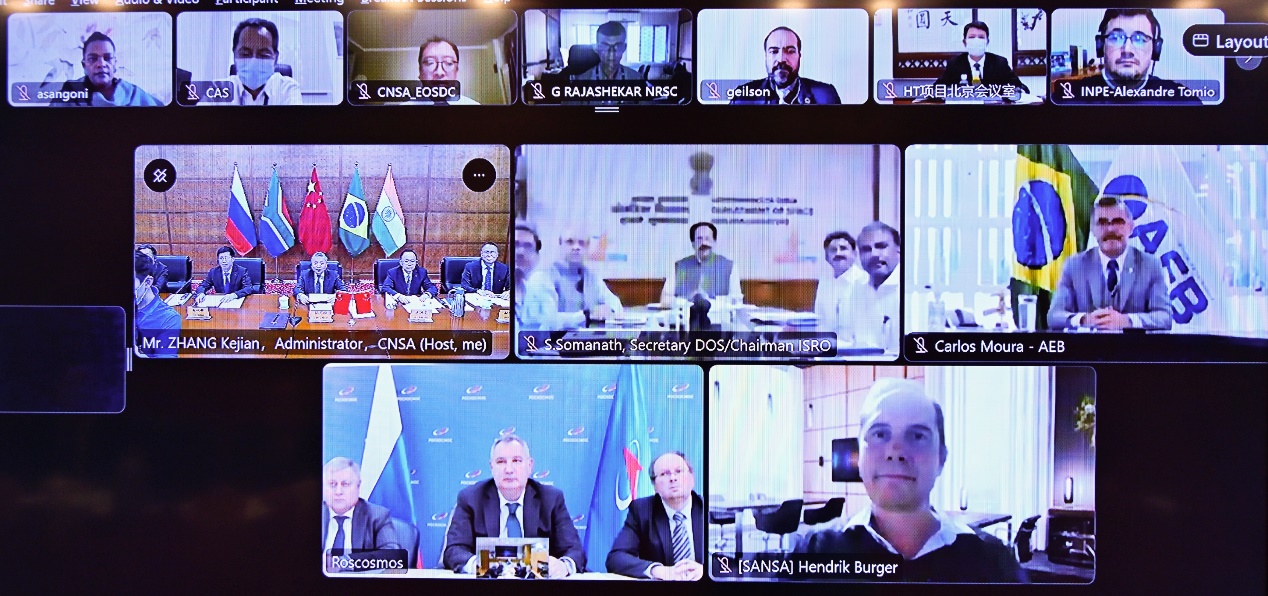BRICS Space Cooperation Joint Committee was established to open the five countries' remote sensing satellite constellation data sharingPublishDate:2022-07-25
According to the National Space Administration, on the evening of May 25th, the first meeting of the BRICS Joint Committee on Space Cooperation was successfully held by video, marking the official establishment of the BRICS Joint Committee on Space Cooperation and the official opening of constellation data sharing. Work with swap.
Zhang Kejian, director of the China National Space Administration, is the chairman of the joint committee this year. Carlos de Mora, director of the Brazilian Space Agency, Rogozin, general manager of Roscosmos, Somanat, chairman of the Indian Space Research Organization, and Chief Engineer Berger, representative of the South African National Space Agency, attended the meeting as members of the joint committee.
Zhang Kejian said that the establishment of the Joint Committee will guide the cooperation of the BRICS remote sensing satellite constellation to better serve the economic and social development of the BRICS countries, and promote a higher level of cooperation among BRICS space agencies in areas such as environmental protection, disaster prevention and mitigation, and addressing climate change, and achieve efficient sharing and effective use of data.
At the meeting, the space agencies of the five countries introduced the space activities carried out by each country in the past year and the implementation of the BRICS Remote Sensing Satellite Constellation Cooperation Agreement. BRICS Remote Sensing Satellite Constellation Data Exchange Technical Specifications and BRICS Remote Sensing Satellite Constellation Joint Observation Implementation Procedures were considered for adoption.

In 2015, the China National Space Administration launched the BRICS Remote Sensing Satellite Constellation Cooperation Initiative. In August 2021, the space agencies of the five countries jointly signed an agreement on the cooperation of the BRICS remote sensing satellite constellation, clarifying the cooperation plan of "six satellites and five stations". The constellation consists of existing BRICS satellites, including China's Gaofen-6 satellite and ZY-3 02 satellite, the China-Brazil Earth Resources Satellite 04 satellite jointly developed by China and Brazil, a Russian Canopus five-satellite satellite and an Indian ZY 2 and 2A satellites. Constellation satellite data is available from ground stations located in Sanya, China, Cuiaba, Brazil, Moscow region, Russia, Shadnagar-Hyderabad, India, and Hartbeeshawk, South Africa.
The establishment of the BRICS Remote Sensing Satellite Virtual Constellation among the BRICS space agencies and the establishment of a data sharing mechanism will help to cope with the challenges faced by mankind such as global climate change, major disasters and environmental protection. The construction of the virtual constellation of remote sensing satellites is divided into two stages. The first stage will establish the virtual orbit constellation of the existing earth remote sensing satellites, and the second stage will be the real constellation. The five countries' remote sensing satellites and ground receiving stations cooperate in the network observation, which can not only reduce the investment in the construction of satellites and ground stations in various countries, but also greatly improve the imaging capability of a single satellite, greatly improve the efficiency of BRICS satellite observation, and form a "value-added" "observation effect.
During this year's China Space Day, the China National Space Administration decided to set up the National Space Administration Satellite Data and Application International Cooperation Center in Wenchang International Space City, Hainan. As the BRICS Remote Sensing Satellite Constellation Data and Application (China) Center, it is responsible for promoting constellation construction coordination, Data reception, processing and distribution, and application promotion help the overall construction of the BRICS constellation.
Over the years, China Aerospace has conducted exchanges and cooperation with many countries and international organizations, including the BRICS, on the basis of equality and mutual benefit, peaceful utilization, and inclusive development. Up to now, China Aerospace has signed 151 space cooperation documents with 51 countries and international organizations to promote the aerospace industry to benefit all mankind. The Fengyun meteorological satellite provides data services to 115 countries and regions around the world. Chang'e-4 carries payloads from four countries, namely the Netherlands, Germany, Sweden and Saudi Arabia, providing Chinese and foreign scientists with a platform for exploring space, conducting scientific experiments and technical verification. China Aerospace is involved in transportation and port management in Pakistan, land planning and river transport supervision in Myanmar, precision agriculture and pest and disease management in Laos, and urban modernization and smart tourism in Brunei.
(Article source: The Paper News APP)
Appendix:


